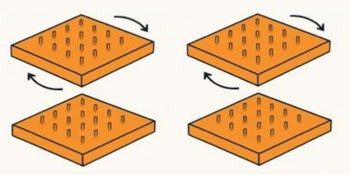
Physicists in the US have invented a way of measuring the magnetic properties of a single molecule as it is being stretched. The technique provides a new approach for studying quantum chemistry and how the spin of an electron affects its passage through tiny structures. The technique could one day even be adapted for use in spintronic devices, which use the spin of the electron to process and store information.
The technique explores an effect first explained in 1964 by the Japanese physicist Jun Kondo. He showed that, at very low temperatures, a conduction electron in a metal such as gold can pair up with an electron of opposite spin associated with a magnetic impurity (such as iron). This tie-up curtails the electron’s ability to conduct current, resulting in a drop in the conductivity of the metal in these chilly conditions.
Physicists have observed this low-temperature fall in conductivity – known as the “Kondo effect” – in a number of bulk materials. However, something very different can happen when electrons confront just a single magnetic impurity, such as a magnetic molecule or a magnetic quantum dot. Studies of electrons flowing from one metallic electrode to another via the magnetic impurity reveal a sharp peak in the conductance of the dot or molecule at zero voltage – dubbed a “Kondo resonance”.
Jumping the barrier
For non-magnetic molecules or quantum dots, conduction is governed by the repulsive electrostatic force between an electron in the metal and an electron in the molecule or dot. Any electron wishing to hop from an electrode and into a molecule or dot must overcome this barrier. In a magnetic system, however, the same pairing interaction described by Kondo lowers this barrier, allowing an electron to jump onto the molecule or dot – and then jump off the other side.
Although this effect has already been seen in dots and molecules with one magnetic electron (spin ½ systems), studying it in higher-spin systems could shed further light on how conduction electrons behave in magnetic materials. Now, a team led by Dan Ralph at Cornell University has studied a Kondo resonance for the first time in a spin 1 molecule. The researchers have also shown that the resonance can be modified by stretching the molecule along one direction.
Triplet state
In the experiment, the team used lithography to first create a gold bridge just 500 nm long and a few tens of nanometres thick and wide on a silicon substrate. A section in the middle of the bridge was removed and a single molecule, comprising one magnetic atom (cobalt) and six pyridine rings, was put in its place.
Cobalt has two magnetic electrons that arrange themselves into a triplet state – a set of three quantum states with identical energies. Both spins point in the same direction, giving cobalt a total spin of 1. When the sample was cooled to about 1.6 K, the team noticed a big drop in the electrical resistance of the molecule at zero applied voltage – the hallmark of a Kondo resonance.
Ralph and colleagues then stretched the molecule by as much as 0.08 nm by bending the silicon substrate. The Kondo resonance was seen to split into two peaks, one on either side of zero applied voltage. According to Ralph, this splitting occurs because stretching the molecule breaks the cubic symmetry of the molecule that is responsible for the triplet states all having the same energy. Instead, one state drops in energy and the size of the drop is related to the size of the splitting.
The team confirmed the magnetic nature of the splitting by repeating the experiment in an applied magnetic field. When the field was applied perpendicularly to the direction of stretch, the splitting gradually got bigger as the field strength was turned up. However, when the field was applied parallel to the stretch, the size of the splitting changed significantly as the field strength was varied. According to Ralph, this behaviour confirms that they are observing a Kondo resonance in a spin 1 molecule.
Ralph and colleagues also looked at how the conductance at zero voltage changes as the sample is warmed from 1.6 K to about 30 K. The drop in conductance was that expected for a spin 1 Kondo resonance.
‘Important experiment’
Pablo Jarillo-Herrero of the Massachusetts Institute of Technology describes the work as “an important experiment” that could lead to better quantum-chemistry calculations, which yield the spin states of a molecule. He also believes that the work could result in the development of tiny magnetic memories that store information in terms of the spin state of the molecule. The work could even lead to the development of new sources of spin-polarized electrons and switches that can turn spin currents on and off.
Ralph told physicsworld.com that the team is now trying to repeat the experiment using electrodes made from a magnetic metal rather than gold. This would allow spin-polarized electrons to be injected into the molecule – which could be an important first step towards the creation of “spintronic” devices.



